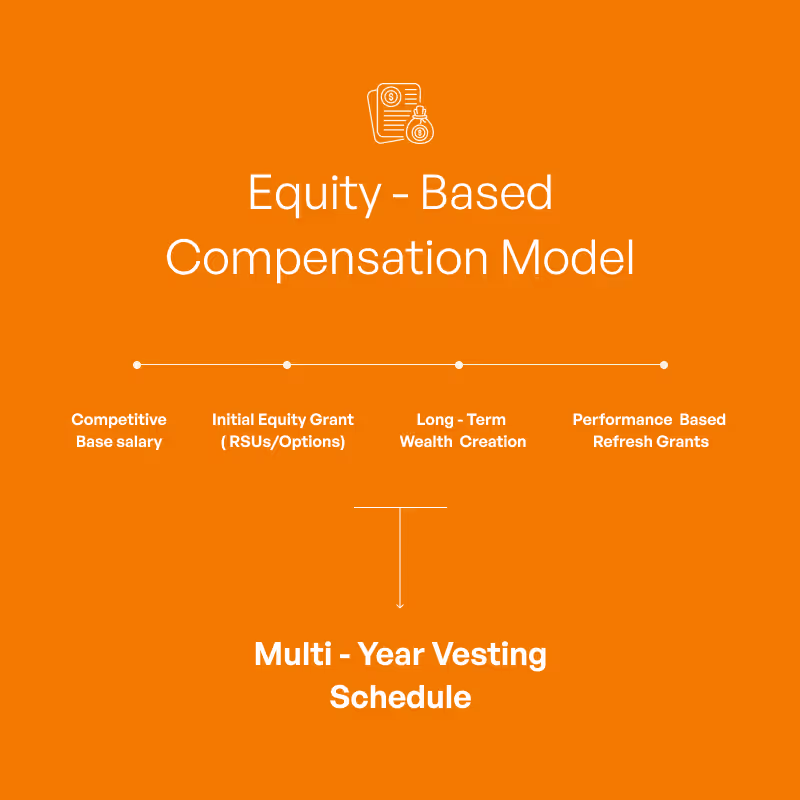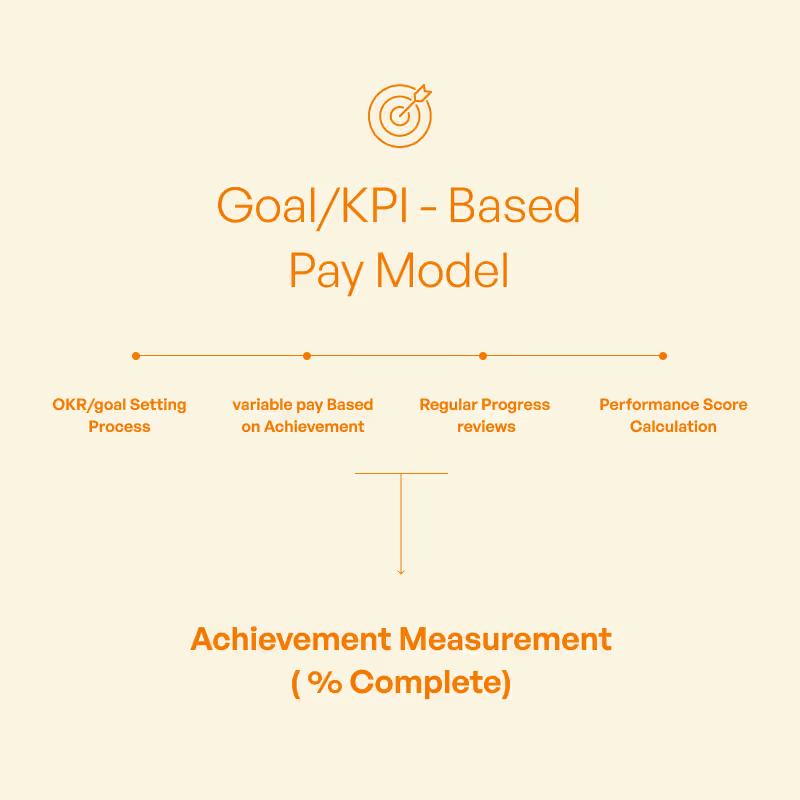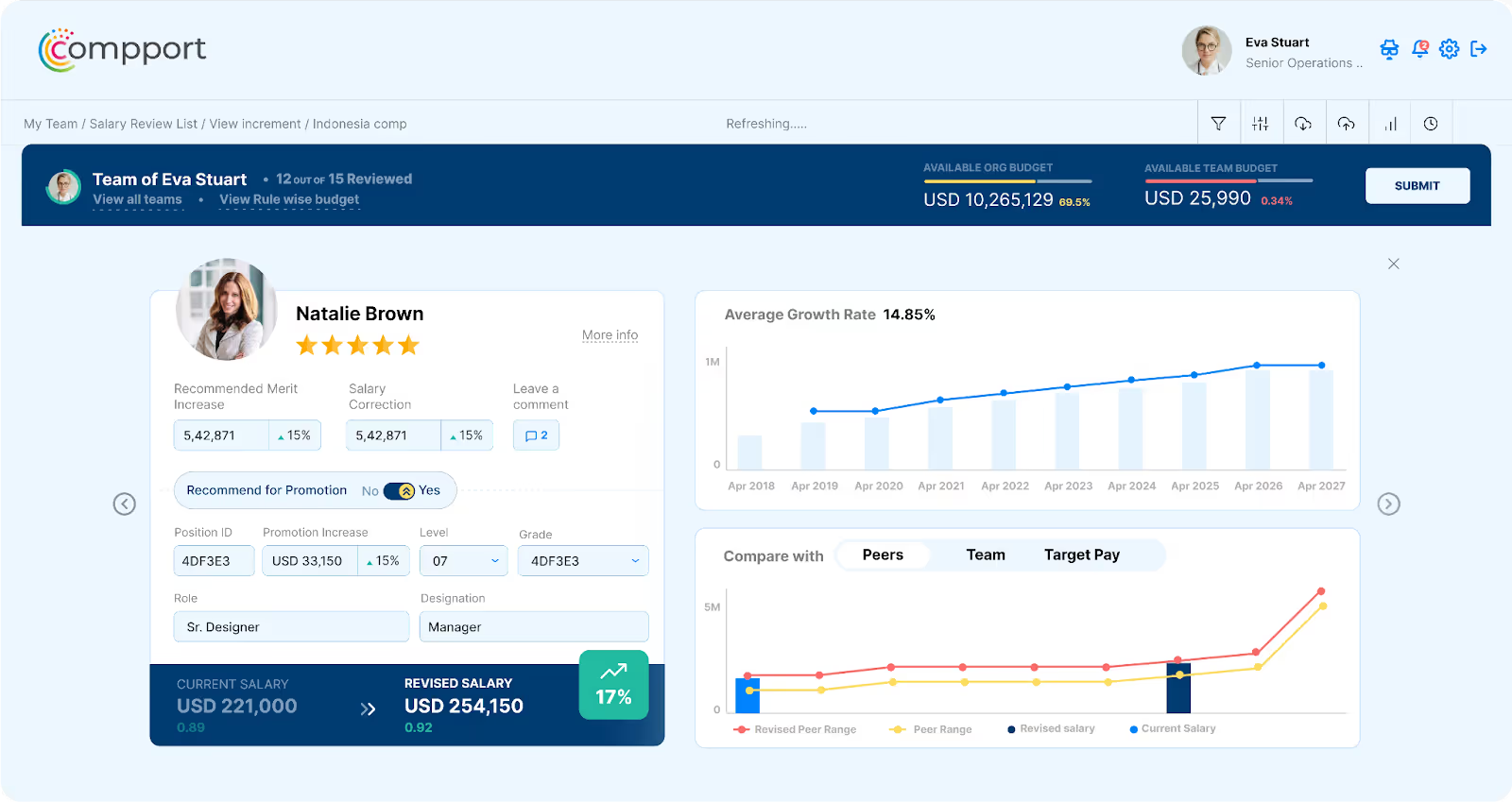What is Pay for Performance in IT? Conditions, Examples and Pay for Performance Models
%20(21).avif)
In the high-stakes world of IT services, talent isn't just an asset—it's the product itself. Yet many organizations face a troubling reality: they're replacing almost their entire workforce every three years.
With IT turnover rates hovering between 13%-20% annually, tech leaders are finally confronting the massive hidden costs behind these statistics. When skilled developers and architects walk out the door, they take critical knowledge that isn't documented anywhere.
Projects stall, clients grow frustrated, and remaining team members shoulder increasing workloads, often triggering more departures. The financial impact is staggering—replacing a single IT professional costs between 50-150% of their annual salary. But strategic compensation approaches can dramatically change this equation.
When organizations stop treating compensation as an administrative function and start leveraging it as a precision tool for retention, the results can be remarkable.
This article explores how effectively implemented Pay for Performance models can transform IT talent retention while delivering measurable ROI through strategic compensation tools that address the hidden costs of turnover, pay equity challenges, and the critical skill-based incentives needed in today's competitive tech marketplace.
🔖Download our Pay Equity Audit Guide
What is Pay for Performance in the IT Services Industry?
Pay for Performance in the IT services industry is a strategic compensation framework that aligns financial rewards with measurable outcomes, where engineers and consultants receive differential compensation based on their quantifiable contributions, acquired skills, and overall impact on business objectives – creating a meritocratic environment that addresses the industry's unique challenge of continuous talent competition.
IBM exemplifies how a comprehensive Pay for Performance approach can effectively align compensation with strategic business evolution. Their framework balances immediate financial metrics with long-term strategic imperatives, tying significant portions of pay to measurable outcomes while emphasizing equity incentives that create an ownership mentality.

This dual focus allows them to reward both traditional performance and contributions toward transforming into cognitive solutions and cloud platforms, demonstrating how P4P models can adapt to shifting business priorities in the dynamic IT landscape.
Why does Pay for Performance matter in IT?
Pay for Performance matters critically in IT because the industry faces a perpetual talent crisis where skilled professionals constantly receive competing market offers. When IT teams engage in peer compensation conversations, which often trigger departures, effective P4P systems provide transparency that builds trust and retention. P4P transforms compensation from an administrative function into a strategic retention tool that preserves critical technical expertise.
Key reasons P4P is essential in IT:
- Direct financial impact - Replacing an IT professional costs between 50-150% of their annual salary, making retention through strategic compensation a major cost-saving measure [Opinnate, 2024]
- Knowledge preservation - When experienced employees leave, they take valuable institutional knowledge about systems and processes that often isn't documented, creating productivity gaps
- Competitive differentiation - In an environment where talent constantly receives market offers, P4P creates meaningful financial incentives that distinguish your compensation approach
- Skills development alignment - Modern P4P models incentivize continuous learning of in-demand technical skills, addressing rapidly evolving technology requirements
- Client relationship continuity - Effective P4P reduces mid-project departures that damage client trust and satisfaction, protecting revenue relationships
Types of Pay for Performance Models: Pros and Cons
Here are the most common types of pay for performance models in the global IT sector:
Bonus-based pay
Bonus-based pay provides employees with additional cash rewards for meeting specific performance targets or achieving certain ratings. These bonuses typically represent a percentage of base salary (commonly 10-20% for mid-level positions and potentially 30%+ for senior roles) and are distributed annually or quarterly based on individual, team, or company-wide performance metrics.

Pros:
- Creates direct financial motivation for high performance
- Allows companies to reward employees without permanently increasing fixed costs
- Can be adjusted based on business conditions and performance
- Enables differentiation between performance levels
- Provides a mechanism to share company success with employees
Cons:
- May create unhealthy internal competition if poorly designed
- Can drive short-term thinking at the expense of long-term goals
- Performance evaluations may contain subjective bias
- Difficult to calibrate across different teams or departments
- It can feel arbitrary if the criteria aren't transparent or consistently applied
Commission-based incentives

Commission-based incentives provide employees with a percentage of the revenue or profit they personally generate. This model creates a direct pay-for-performance link where earnings increase proportionally with sales or other revenue-generating activities. Typically structured with a lower base salary plus variable commission (often in a 60/40 or 50/50 ratio), with opportunities for accelerated rates when exceeding targets.
Pros:
- Creates perfect alignment with revenue generation
- Self-funding (increases in pay directly tied to increases in revenue)
- Provides unlimited earning potential for top performers
- Attracts and retains highly motivated, results-oriented individuals
- Clear, objective measurement of performance
Cons:
- Limited applicability to non-sales technical roles
- Can lead to burnout from intense focus on numbers
- Might encourage prioritizing quantity over quality or customer satisfaction
- Creates earnings volatility that some employees find stressful
- May drive unhealthy internal competition for leads/accounts
Equity-based compensation

Equity-based compensation grants employees ownership stakes in the company, typically through Restricted Stock Units (RSUs) or stock options. These awards vest over a multi-year period (commonly 4 years), and their ultimate value depends on the company's stock performance. Equity serves as both a performance incentive and retention tool, with additional refresh grants often awarded based on performance.
Pros:
- Creates an ownership mentality that aligns employee and shareholder interests
- Provides significant wealth creation opportunity, especially in growth companies
- Serves as a powerful retention tool through multi-year vesting schedules
- Tax-advantaged compensation compared to equivalent cash in many jurisdictions
- Rewards long-term thinking and sustainable performance
Cons:
- Value is affected by market factors outside individual control
- Complex to explain and appreciate, especially for employees new to equity
- Less motivating during stock market downturns or company valuation challenges
- Creates "golden handcuffs" that may retain employees for financial rather than engagement reasons
- Dilutes existing shareholders and creates accounting expenses for the company
Goal/KPI-based pay

Goal or KPI-based pay ties compensation directly to the achievement of specific, measurable objectives established at the beginning of a performance period. This model uses frameworks like OKRs (Objectives and Key Results) or MBOs (Management by Objectives) to set clear targets, then awards variable pay based on the percentage of goal attainment, often with thresholds, targets, and stretch levels.
Pros:
- Focuses employee effort on specific strategic priorities
- Provides clear performance expectations and objective measurement
- Can be tailored to different roles, teams, and business needs
- Promotes transparency in compensation decisions
- Drives accountability for key results
Cons:
- Goals can become outdated in rapidly changing environments
- Risk of employees optimizing for measured goals at the expense of unmeasured activities
- Can be complex to administer effectively at scale
- Challenging to set appropriate difficulty levels across diverse roles
- May create silos if goals don't encourage collaboration
Skills-based pay

Skills-based pay rewards employees for acquiring and applying valuable skills rather than solely for job title or performance outputs. This model creates compensation tiers or premiums based on demonstrated proficiency in high-demand technical skills, certifications, or competencies. Employees can increase their compensation by developing new skills that align with the organization's needs, even without changing their roles or titles.
Pros:
- Encourages continuous learning and professional development
- Directly addresses technical skills gaps in the organization
- Rewards employees for increasing their market value and contribution potential
- Appeals to technical professionals who value mastery and expertise
- More forward-looking than traditional backward-looking performance reviews
Cons:
- Requires sophisticated assessment methodology to evaluate skill proficiency
- Complex to administer and maintain as technology and market demands evolve
- May not account for the actual application of skills in delivering business value
- Challenging to price skills accurately and consistently in volatile labor markets
- Can create perception issues if skill valuation isn't transparent and well-communicated
How does Pay for Performance Work in the Global IT Sector?
In the global IT sector, Pay for Performance transcends traditional geographic compensation models by creating outcome-based reward systems that function across distributed teams.
Multinational tech firms implement P4P through standardized performance metrics while allowing for regional market adjustments. This creates a dual-layer approach: core performance metrics remain consistent globally (code quality, project outcomes, client satisfaction), while the financial rewards reflect local market conditions.
The key distinction from traditional models is that global P4P systems measure performance using unified standards regardless of location, then translate those outcomes into locally relevant compensation. This addresses both performance alignment and geographic pay equity challenges simultaneously.
As Krish Shanker, former Group Human Resource Officer at Infosys, explained: "You build a philosophy which really is a longer-term thing... Then you come up with saying okay, where are the pockets where there are local issues, because there's huge competition in one country, or there is huge attrition in another place... You've got to go down and say oka,y what is the context of that business... So I think it's a level of ensuring that you have various layers in which you manage."
How to Implement a Pay for Performance Model? Tips and Strategies
Implementing an effective Pay for Performance (P4P) model requires strategic planning, the right tools, and a ongoing commitment. Here are three key strategies to ensure your P4P implementation delivers maximum impact:
Get a compensation management software
The foundation of any successful P4P implementation is having the right technological infrastructure in place. Specialized compensation management platforms like Compport transform what was once a complex, error-prone process into a streamlined operation that enables strategic decision-making.

Modern compensation software serves as the technological backbone of P4P by providing:
- Centralized data management: All compensation information lives in one secure place, eliminating spreadsheet chaos that often leads to errors and pay inequities
- Rule-based automation: Performance metrics and compensation rules can be configured to calculate appropriate rewards based on achievement levels automatically
- Budget modeling capabilities: Organizations can run multiple compensation scenarios to understand the financial impact before implementation
- Analytics and insights: Real-time dashboards provide visibility into compensation distribution, helping identify potential bias or inequities
Design clear, objective performance metrics tied to strategic goals
The effectiveness of any P4P model depends heavily on selecting the right performance metrics. Without clear, measurable indicators of success, compensation decisions become subjective and potentially biased.
When implementing P4P, organizations should:
- Align metrics with business strategy: Select performance indicators that directly connect to organizational objectives. For IT roles, this might include on-time project delivery, code quality metrics, client satisfaction scores, or contributions to innovation.
- Balance individual and team measures: Create a performance framework that rewards both personal achievement and collaborative success, preventing unhealthy competition.
- Make metrics visible and transparent: Ensure that employees understand exactly how their performance will be measured and how it is translated into compensation.
- Incorporate both quantitative and qualitative elements: While data-driven metrics provide objectivity, qualitative assessments, such as peer feedback and leadership evaluation, add important context.
Krish Shanker emphasizes that "when you're looking at this, I don't think you need to come up with new initiatives every time but I think you got to maybe once in a way check whether your what you're planning to do is meeting its objectives."
🔖 Tune in to our podcast Compensation & Coffee on Spotify to learn more
This highlights the importance of regularly reviewing whether your performance metrics are driving the intended behaviors and results.
The most successful implementations create a direct line of sight between daily work, performance metrics, and compensation outcomes. Employees should clearly understand "if I achieve X, I will receive Y" - removing ambiguity from the P4P equation.
Train managers and ensure open communication
Even the best-designed P4P system will fail without proper manager training and clear communication. Managers are the frontline implementers of any P4P program, making their understanding and buy-in essential.
Effective implementation requires:
- Comprehensive manager training: Ensure managers understand how to set realistic goals, evaluate performance fairly, and communicate compensation decisions clearly and effectively.
- Calibration sessions: Hold cross-functional meetings where managers review and align on performance ratings to ensure consistency and fairness across teams.
- Transparent communication: Create clear documentation and resources that explain how the P4P system works, including specific examples and calculations.
- Regular feedback loops: Establish mechanisms to gather feedback from both employees and managers about the P4P program, enabling continuous improvement.
The communication aspect is crucial and cannot be overstated. Employees need to understand not just what they're being paid, but why they're being paid that amount. Total Rewards Statements provide employees with comprehensive visibility into their complete compensation package, reinforcing the connection between performance and rewards.
By combining specialized compensation technology, strategic performance metrics, and well-prepared managers, organizations can implement P4P models that drive performance while fostering engagement and retention. The key is creating a system that employees perceive as fair, transparent, and aligned with both individual and organizational success.
Time to Sign Up for a Compensation Software
Effective Pay for Performance systems transform IT talent retention by directly linking rewards to measurable outcomes. As we've explored, strategic P4P implementation requires thoughtful metric design, management training, and crucially, the right technological foundation. Modern compensation platforms eliminate spreadsheet chaos, automate calculations, enable budget modeling, and provide crucial analytics, reducing administrative work while improving decision quality. In today's competitive tech landscape, organizations can't afford the hidden costs of turnover.
Compport's intuitive interface, powerful rule engine, and data-driven insights make implementing sophisticated P4P models straightforward, turning compensation from an administrative burden into a strategic advantage that preserves your most valuable asset: your talent.

FAQs
What is the meaning of pay for performance?
Pay for Performance is a compensation strategy that links an employee's financial rewards directly to their measurable contributions and achievements, creating a system where exceptional performers receive higher compensation through various incentive components.
Is performance pay part of CTC?
Yes, performance pay is typically included in Cost to Company (CTC) calculations as a variable component that reflects the potential total compensation an employee may earn based on achieving targets.
What is the meaning of PFP bonus?
A PFP (Pay for Performance) bonus is a variable financial reward given to employees based on achieving specific performance metrics, typically calculated as a percentage of base salary and distributed quarterly or annually.


%20(34).avif)
%20(50).png)
%20(49).png)
